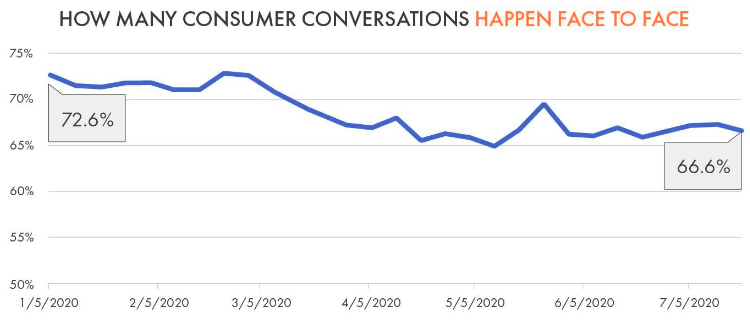Commentary
Word-Of-Mouth Remains Vital To Consumers During COVID-19
- by Ed Keller , July 31, 2020

The COVID-19 pandemic may have cleared out offices, public transit, bars, restaurants, and social gatherings, but Americans have continued to enjoy their gift for gab when it comes to talking about and recommending brands.
Compared to a year ago, consumer talk is up by double digits in social media. Yet despite social distancing rules, real-world offline word-of-mouth conversations are also up 2% between April and July, compared to the same time last year. During this period, that amounts to 14 billion weekly word-of-mouth impressions about products, services and brands.
Consumer conversations are important because they have been shown to motivate 19% of consumer sales, with online and offline conversations playing equally important roles. Yet there is no correlation between online and offline conversations, making it important to pay attention to both.
advertisement
advertisement
While offline conversations are up 2%, how and where those conversations are occurring has changed somewhat. For starters, a larger percentage now occur at home, with more people hunkered down and avoiding going out. About 70% of all conversations about consumer categories and brands now occur at home, versus about 63% prior to the pandemic. The increase became most noticeable the first week of April and hit 70% by the end of that month.
Two-thirds of those conversations at home are happening face-to-face with other household members, but many involve telephone, text, email to people outside of the home, providing ways for people to share information about products and services with each other at social distance. Indeed, we believe word-of-mouth has become more important as consumers are seeking help from each other as they navigate their changed lives. As we reported recently, increasing word-of-mouth conversation activity related to health and healthcare (+29%), household products (+18%), beauty (+16%), entertainment (+13%), and financial services (+10%) are indications of the changing needs of consumers amid the pandemic.

The importance of social distancing is showing up in the slight decline in face-to-face conversations and the rapid rise of video calls as an important new mode of conversation. Face-to-Face conversations have dropped 6 points, from 72.6% of all conversations to 66.6% between January and mid-July, with the first noticeable shift occurring in late March and early April.

The main channel showing an increase in conversation are video calls, which rose from 1.3% of all consumer conversation the first week of April to 4.3% by mid-July. Interestingly, video calls initially rose and peaked in May, then declined, before resuming an upward trajectory in July. The pattern would seem to be consistent with hopes for a national reopening in June that proved illusory by mid-July.
The only other modes of communication that rose during the period were phone and text and instant message, up about 1 percentage point each.

While video calls are responsible for a fairly small percentage of total conversations, when multiplied by the average weekly total of 14 billion conversation impressions, one finds they account for about 600 million per week, which is the number of instances a person has participated in a consumer conversation via video call.
Furthermore, the people participating in video calls are extremely influential. More than a third (34%) of people participating in video calls are part of the influential segment of consumers we refer to as the everyday consumer influencers, more than triple their incidence in the general population
Everyday consumer influencers are people who frequently give advice and have large real-world social networks. Indeed, video call participants are more apt to be influencers even compared to people participating in conversations via social media (21%).

The COVID-19 pandemic has changed our lives in ways unimaginable even six months ago. Peer influence through word-of-mouth has only become more important, as people are turning to trusted friends and family for navigating life-and-death decisions, as well as the little things that make life under lockdown livable.
It turns out, Americans do not require a water cooler at the office to share products, ideas, and experiences. They are quickly finding new places to gather — even when they are apart.


